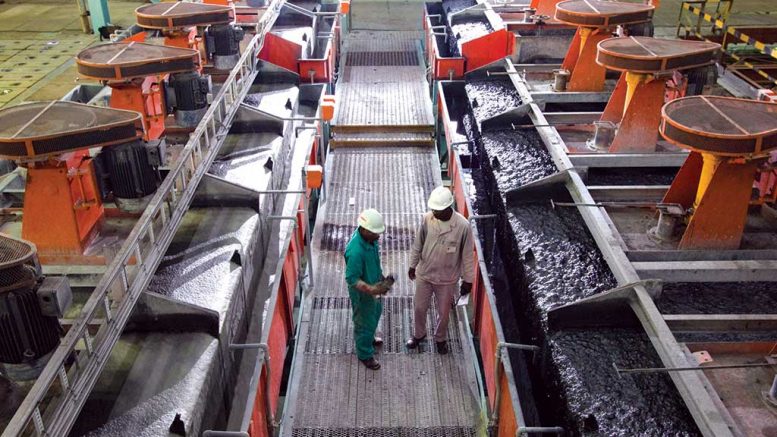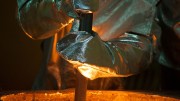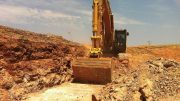Cobalt has more than doubled in price from US$14.75 per lb. in late December 2016 to over US$30 per lb., making it one of the top performing metals this year. With the lion’s share of cobalt mined in the Democratic Republic of the Congo and refined in China, what will the market look like over the coming years? Jack Bedder, an expert on the metal at Roskill, an independent metals and minerals research company in the U.K., completed a report in November called: “Cobalt: Global Industry, Markets & Outlook,” and recently spoke with The Northern Miner about the short-term and longer-term outlook for cobalt, and what he sees as its key supply and demand issues over the next decade.
The Northern Miner: The cobalt market is worth an estimated US$6.6 billion annually. How large do you see the market growing over the next decade?
Jack Bedder: As a ballpark that’s about right. I guess that assumes a 100,000-tonne market and a price of US$30 per lb., which are a fair reflection of the last few months. Currently the market is closer to 110,000 tonnes and the price is as high as US$34 per lb., which pushes the market above US$8 billion!
TNM: BMO Capital Markets recently raised its cobalt price forecasts for 2018 to US$30.9 per lb., US$40 per lb. in 2019, US$38.8 per lb. in 2020 and US$22.5 per lb for the long-term. Roskill released its second quarterly update on the cobalt market at the end of November. Do your price forecasts look similar to BMO’s?
JB: Our numbers for next year are probably about the same as BMO’s. I think the price will hover around the US$30 to $35 per lb. range for the rest of the decade. We’re not expecting a massive price hike next year.
TNM: What has been the demand growth for cobalt over the last decade and what are your demand growth projections for the next decade? How much do you see annual global demand for cobalt growing between now and 2030?
JB: Cobalt has seen rapid demand growth since 2000, and that’s been underpinned by demand for cobalt in the cathodes of lithium-ion batteries used in portable electronics, smart phones and laptops, et cetera. [Last year in 2016] was the first time we saw consumption fall, because it’s become a quite saturated market. We still expect strong and stable cobalt demand for use in portable electronics, but that’s not where the growth is really going to come from in the future, it’s going to come from electric vehicles.
Cobalt became a greater than 100,000-tonne-a-year market in 2015, and was closer to 110,000 last year. Consumption grew 9% between 2009 and 2016. A lot of that growth was supported by demand in the battery sector. Cobalt consumption for batteries increased 16% per year between 2009 and 2016.
So the historic picture is one of robust growth for cobalt demand in batteries, mainly underpinned by electronics. But the future is going to be driven by electric vehicles. Our forecast suggests cobalt demand from batteries in general could reach 230,000 tonnes a year by 2026, and most of it will come from electric vehicles.
TNM: How do you see the supply-demand equation for cobalt evolving over the next decade?
JB: There are two aspects to this: There is refined cobalt production — either a cobalt chemical or a cobalt metal — and then there’s the feedstock that underpins refined production, which comes mainly from mining.
In terms of refined supply, the market is going to need new capacity to come onstream to keep up with demand. China accounts for 60% of the world’s refined capacity, and much of that new capacity is also going to come from China. When we look at expanding that refined supply, the big players in China are already set to add 60,000 tonnes over the next couple of years. Even more capacity is going to be needed thereafter, but that shouldn’t be a problem. The battery narrative is very strong, which helps raise finance. It doesn’t take too long to turn on a new production line and I don’t think the capex is particularly high. So while new refined capacity needs to be built, there’s probably going to be enough refined supply until the end of the decade.

The processing plant at the Tenke Fungurume copper-cobalt mine in the Democractic Republic of the Congo. Credit: Freeport-McMoRan.
The big question is whether there will be enough feedstock to supply refined cobalt production. That’s why you have so many juniors getting really excited. There was 110,000 tonnes of cobalt mined last year and if you extrapolate that forward, and include the big projects that will come onstream from Glencore and Eurasian Resources Group (ERG), there should be enough feedstock toward the end of the decade, but after that there’s a big question whether it will be enough after 2021.
TNM: And where would it likely come from?
JB: It’s hard to say where it would come from. You could get further expansion from existing producers, maybe improve recovery techniques, getting more cobalt out of copper production, new mine projects, maybe more artisanal supply from producers in the DRC, although there’s only so much that can be produced from them — maybe 5,000 tonnes extra a year — or large tailings dumps in the Congo, getting more cobalt from copper tailings or from nickel operations. The nickel market has had a tough time but if some nickel operations start producing, you might get more cobalt units. So all of those things combined, with further expansion of existing operations being the big one.
We’re independent and not beholden to anyone, and most of our competitors have different numbers than we do, but everyone supports the view that it will be a tight market to the end of the decade. After that it’s unknown. I have a list … of 140 current projects that mention cobalt, but less than 10 of those have any chance of coming onstream within the next five years. Of those you’ve got Glencore restarting Katanga, ERG’s RTR project in the Congo, and there a couple of others that are at more advanced stages, but most of those 140 projects I mentioned aren’t even at the feasibility study stage.
It’s not surprising seeing so many juniors in places like Canada and Australia flying their cobalt flags. But it won’t be junior miners that are going to be the answer to filling the feedstock gap — maybe they might produce a couple thousand tonnes a year — but that’s a drop in the ocean of what demand is expected to be.
If you’re looking to switch on a project before 2020 you want to be well past the feasibility study level by now. We know it can take a long time to build a mine and there are just very few projects that are past the feasibility stage, except for the ones in the Congo. And it might be quicker to turn on a project in Africa, where permitting isn’t as difficult as it would be in a place like Canada or Australia. Then again, in Africa, you have infrastructure challenges and rainy seasons, and so forth. But if you think you can turn on cobalt projects quickly, it’s just not going to happen.
TNM: Can you summarize your outlook?
JB: If you take our demand expectations, battery demand is going to reach 230,000 tonnes a year by 2026, and if you think that demand is going to grow that way, then the question is whether there is going to be enough refined cobalt to meet that demand. We think there will be, but it will require more capacity brought onstream, which will be challenging but doable. But the main question is whether there will be enough feedstock to meet that demand. We think new supply will come from a combination of factors: from expanding supply at existing operations, to better cobalt recoveries, perhaps more from recycling and ultimately demand destruction. So that overall picture supports elevated cobalt prices over the next few years.
TNM: China has next to no domestic source of cobalt and depends on international markets — essentially the DRC — for most of its supply. Do you expect to see supply shocks?
JB: There is very limited mine production in China and obviously it’s the biggest refined producer, so most of the refined production is based on imported cobalt from the DRC. In 2016, China’s mined product accounted for 2% of the global mined total. There’s some cobalt in China as a by-product of iron oxide or copper-gold production. The DRC makes up 68% of the world’s mined cobalt.
TNM: Could more cobalt come from recycling? Some figures show just 10% of cobalt is currently recycled.
JB: Probably not even that much. If we’re talking about recycling a lot of it is captured at various points in the supply chain, but essentially there’s not too much that is recycled from portable electronics. The big question is whether the giant batteries used in electric vehicles can be recycled, and it all depends on the price. There is some recycling already but if we say the lifespan of a typical battery used in an electric vehicle is between five and eight years, and electric vehicles are still in their infancy, you’re not going to see huge amounts coming back for at least another five years. Even then, those batteries may find new applications in home energy storage.
TNM: Most of the world’s cobalt has been found in association with copper and nickel deposits. CleanTeq’s Sunrise deposit in Australia is an exception. Do you think there is potential to find more primary sources of cobalt?
JB: Potentially. The definition of “primary” depends a lot on the cobalt price compared to the price of other metals in a deposit. [CleanTeq’s Sunrise deposit] contains nickel. At current prices some projects can be deemed cobalt-nickel projects. If cobalt prices fall and nickel prices rise, they will be nickel-cobalt projects.
TNM: Do you think concerns over child labour in the DRC could lead to a premium emerging for cobalt that is mined elsewhere, in countries like Canada and Australia?
JB: A lot has been done to stamp out child mining, but much more needs to be done. It’s the responsibility of the whole industry. There’s certainly been talk of a premium for “ethical” cobalt, voiced in part by producers that are able to prove that their cobalt is in no way associated with human rights issues. But it’s not just about the miners, it’s about the whole supply chain.
To prove that cobalt used in an end-product, say a smartphone, is free from child mining, the producers have to be able to guarantee that at no stage in its journey — from mine deposit, through to cobalt chemical production and through to the battery production line — that no cobalt units have come into contact with cobalt units from an unknown, or worse, illegal, source. If at any point in the supply chain, cobalt units of unknown provenance are used, you cannot say the cobalt product is child-labour free.






Be the first to comment on "Roskill’s Jack Bedder peers into cobalt crystal ball"